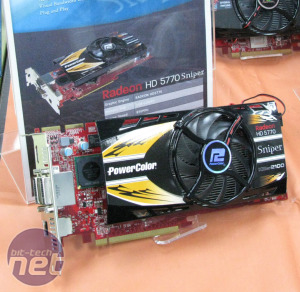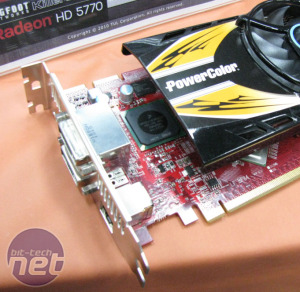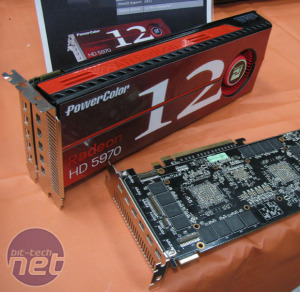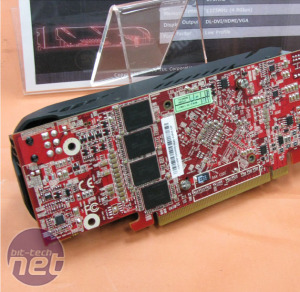Crazy New Graphics Cards from PowerColor
June 7, 2010 | 11:12
Companies: #powercolor #powercolorcolor

PowerColor shows off crazy new HD 5770s
Manufacturer: PowerColorLast week out at Computex we saw plenty of graphics card makers, but one that particularly impressed us was PowerColor, who unveiled a new range of ATI Radeon HD 5770s unlike any we've seen before. While the HD 5770 might be seen as mid- to low-end cards by enthusiasts looking for maximum detail settings and the highest frame rates, its competitive price tag and strong availability has seen it emerge as arguably this generation's most popular card. PowerColor has plenty of ideas to set its cards apart.
Click to enlarge - Would you like a Network card with your GPU?
First up is the PowerColor HD 5770 Sniper, the first card to combine a GPU and a network card – that’s right, it has a high-performance network card right there on the PCB. The design integrates a Bigfoot Networks Killer 2100 network processor and a PCI-E splitter onto the PCB, with the card's bac plate sporting a Gigabit network port alongside two DVI and and an HDMI port.
The Killer 2100 looks to be a much more capable version of the Killer Xeno Pro and if the price is right the Sniper could be a very interesting offering. However, we worry that the mid-range graphics power of the HD 5770 GPU might not be enough for every pro gamer looking to minimise their ping.
PowerColor told us that this card would be targeting players of games such as Counter Strike, where graphical performance is secondary to reaction times. That said, we can’t see any reason why this sort of upgrade couldn’t be applied to more powerful cards such as the Radeon HD 5870 or HD 5850 if there’s enough interest in the Sniper.
Click to enlarge - The inclusion of an onboard Hydra chip could be revolutionary, while a 12 display HD 5970 is sure to please giant screen fans
Not content with cramming a network card onto an HD 5770, PowerColor was also showing a teeny-tiny half height HD 5770, perfect for a HTPC (home theatre PC) or a seriously small gaming build. The dual slot card still packs in the 1GB of GDDR5 memory and is even pre-overclocked. Downsizing a full-size graphics card to such an extent is something we’ve never seen before, although we didn't see the card running, so we can't comment on whether the two 40mm cooling fans are quiet or not.
Click to enlarge - The half height HD 5770 was particularly nifty
If that wasn't enough, PowerColor also had the HD 5770 Evolution, the first graphics card with Lucid Hydra on board, a potentially revolutionary addition to the graphics market. As it does on MSI's (and soon Asus’) motherboards, the Hydra chip allows any graphics card to work in a multi-card setup with any other graphics card, regardless of make, model or SLI and CrossFire support on the motherboard, and all without any bridge connectors.
PowerColor said that the setup works best with comparably powered cards, making the Evolution a possibly ideal upgrade to all those who bought a GeForce GTX 260 (rev 2). While we remain skeptical about the performance gains and practicality of the Hydra driver supporting every graphics card combination, it’s certainly an interesting concept and we can’t get wait to get one in and start testing [Well volunteered, Harry - Ed].
Topping things off, PowerColor also had the first Radeon HD 5970 4GB 12-display graphics card we've seen – ideal for when you want to add that entire wall of displays to your living room. While the card is obviously targeted towards businesses like stadium owners or TV stations rather than gamers (even a pair of HD 5970s could struggle to play games smoothly at 7,680 x 3,240) it's an undeniably cool accomplishment, with the extra displays connecting via a daughterboard on the card’s rear.
Impressed by PowerColor's technical wizardry? Excited about the arrival of a Hydra or low-ping network controller on a graphics card? Or do you crave a 12-display wall of gaming? Let us know in the forums.

MSI MPG Velox 100R Chassis Review
October 14 2021 | 15:04














Want to comment? Please log in.